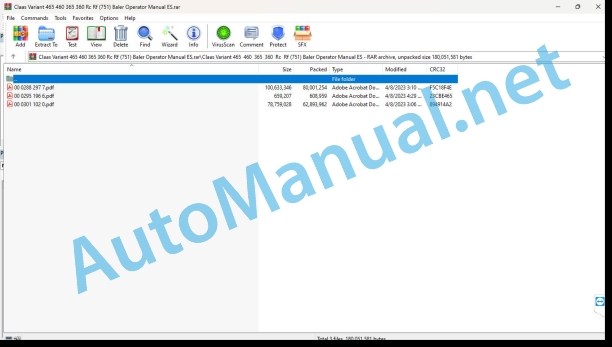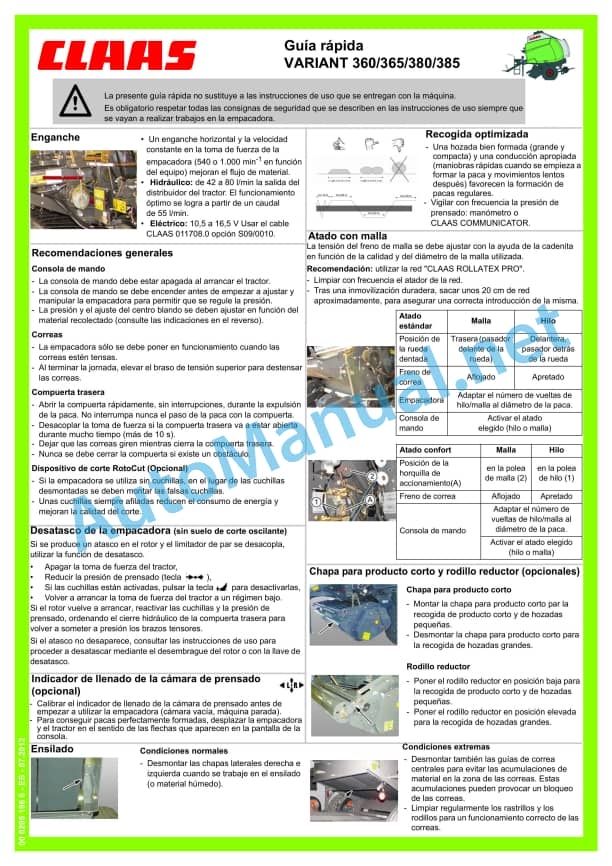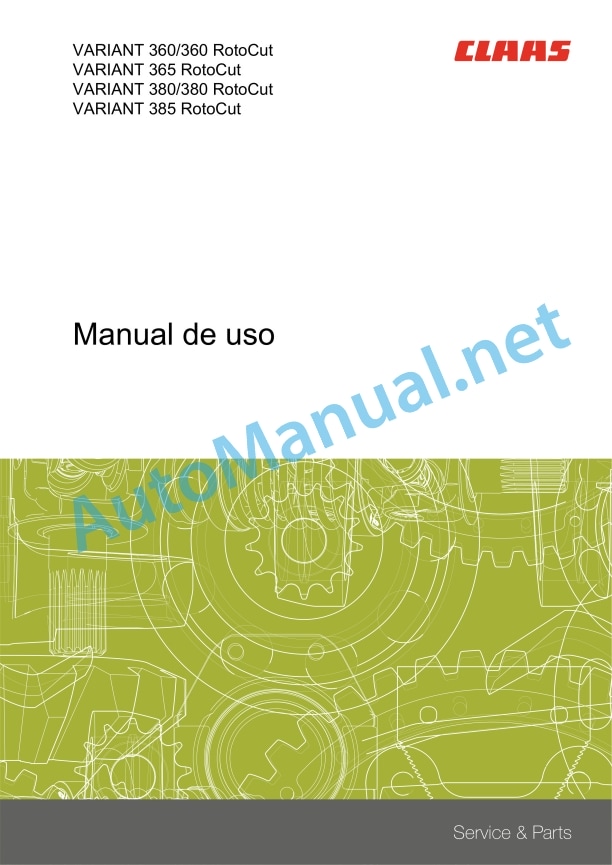Claas Variant 465 460 365 360 Rc Rf (751) Baler Operator Manual ES
$50.00
- Model: Variant 465 460 365 360 Rc Rf (751) Baler
- Type Of Manual: Operator Manual
- Language: ES
- Format: PDF(s)
- Size: 137 MB
File List:
00 0288 297 7.pdf
00 0295 196 6.pdf
00 0301 102 0.pdf
00 0288 297 7.pdf:
VARIANT 485 ROTO CUTVARIANT 480 / 480 ROTO CUTVARIANT 465 ROTO CUTVARIANT 460 / 460 ROTO CUT
1. Introduction
1.1 General information
1.1.1 Application of this manual
1.1.2 Information relating to this instruction manual
1.1.3 Symbols and indications
1.1.4 Optional equipment
1.1.5 Qualified specialized workshop
1.1.6 Maintenance instructions
1.1.7 Information regarding warranty
1.1.8 Spare parts and technical issues
1.2 Proper application of the machine
1.2.1 Authorized use
1.2.2 Reasonably foreseeable misuse
2 Security
2.1 Recognize warning signs
2.1.1 Danger symbols
2.1.2 Keyword
2.2 Safety instructions
2.2.1 Meaning of the instruction manual
2.2.2 Observe graphic danger symbols and alarm indications
2.2.3 Requirements for all people working with the machine
2.2.4 Children in danger
2.2.5 Danger zones
2.2.6 Position yourself between the tractor and the machine
2.2.7 Accompanying persons
2.2.8 Couple the tractor with the machine
2.2.9 Risk of injury due to rotating shafts
2.2.10 Construction modifications
2.2.11 Optional equipment and spare parts
2.2.12 Control of the tractor in operation
2.2.13 Use only after correct start-up
2.2.14 Technical status
2.2.15 Danger due to machine breakdowns
2.2.16 Comply with technical limit values
2.2.17 Danger due to coasting parts
2.2.18 Maintain functional protection devices
2.2.19 Personal protective equipment
2.2.20 Wear appropriate clothing
2.2.21 Remove dirt and loose objects
2.2.22 Prepare the machine for road traffic
2.2.23 Dangers when driving on the road and in the countryside
2.2.24 Park the machine safely
2.2.25 Parking without supervision
2.2.26 Consumables that do not meet the requirements
2.2.27 Safe handling of consumables and auxiliary materials
2.2.28 Environmental protection and waste disposal
2.2.29 Fire protection
2.2.30 Very dangerous electrical discharge from overhead power lines
2.2.31 Electrical shock from electrical equipment
2.2.32 Liquids under pressure
2.2.33 Pressurized air
2.2.34 Hot surfaces
2.2.35 Work only on the stopped machine
2.2.36 Maintenance work and repair work
2.2.37 Machine parts and lifted loads
2.2.38 Risks derived from welding work
2.3 Graphic danger symbols
2.3.1 Structure of graphic hazard symbols
2.3.2 Location of safety stickers
3 Machine Description
3.1 Existing models
3.1.1 Designation of machines
3.2 Overview and functions
3.2.1 Left side
3.2.2 Right side
3.2.3 Roller identification
3.3 Safety equipment
3.3.1 Signal lighting
3.3.2 Reflective equipment
Clearance reflectors
Machine not braked
Braked machine
3.3.3 Surety
3.3.4 Shims
3.3.5 Holding cable*
3.3.6 Parking brake
3.3.7 Tailgate lock
3.3.8 Locking the pick-up
3.3.9 Fire extinguisher
3.3.10 Main box outlet protection without twine tying
3.4 Work and service positions
3.4.1 General information
3.4.2 Front of the baler
3.5 Identification plate and serial number
3.5.1 Spare parts and technical information
3.5.2 Serial number, identification number or VIN code
3.5.3 Machine identification plate
Identification plate for machines with European approval
Identification plate for machines without European approval
Identification plate for the countries of the Customs Union (Belarus, Kazakhstan, Russia)
3.5.4 Rudder identification plate*
3.5.5 Axle identification plate
3.6 General operating principle
3.6.1 Bale pressing cycle
3.7 Machine information
3.7.1 Location of information stickers
3.8 Control terminal
3.8.1 Control terminal
3.8.2 ISOBUS connection
3.8.3 EASY on board
3.9 Transmission and drive
3.9.1 Transmission
3.9.2 Drive
3.9.3 Drive Chains
3.9.4 Pick-up drive
3.9.5 Rotor drive
3.10 Trailer support
3.10.1 Types of coupling
3.11 Harvest harvest
3.11.1 Pick-up
Pick-up wheels
Rotating pick-up wheels
Foldable swivel pick-up wheels
3.11.2 Compactor
3.11.3 Short straw plate*
3.11.4 Reduction roller*
3.11.5 Double reduction roller*
3.12 Power supply unit
3.12.1 Rotor
3.12.2 Rotor frame with folding bottom*
3.12.3 RotoCut* cutting device
3.12.4 RotoCut HeavyDuty* cutting device
3.12.5 False blades*
3.13 Pressing system
3.13.1 Pressing chamber and belts
3.13.2 Loose core
3.13.3 Management of peripheral layers
3.13.4 Pressing chamber filling indicator*
3.13.5 Humidity sensor*
3.14 Tying system
3.14.1 Tying categories and types
3.14.2 Standard tying
3.14.3 Comfort binding
3.14.4 Tying with thread
3.14.5 Tying with mesh
3.14.6 Tying with Extra wide mesh*
3.14.7 Bundling introduction plate
3.14.8 Tying process
3.14.9 Yarn/mesh box
3.15 Unloading bales
3.15.1 Bale unloading ramp
3.16 Lubrication system
3.16.1 Automatic chain lubrication
3.17 Greasing system
3.17.1 Manual centralized lubrication
3.17.2 Electric automatic centralized lubrication*
3.18 Brake
3.18.1 Hydraulic braking
3.18.2 Active hydraulic braking*
3.18.3 Pneumatic braking
3.19 Hydraulic system
3.19.1 Baler Hydraulic Block
3.19.2 Active hydraulic system
3.19.3
3.20 Equipment
3.20.1 Ladder
3.20.2 Stirrup
3.20.3 Modules
3.20.4 Anti-theft
3.20.5 Mesh compartment cover*
3.20.6 Work lighting*
4 Control and display instruments
4.1 COMMUNICATOR II
4.1.1 Presentation
4.1.2 Description of the COMMUNICATOR
00 0295 196 6.pdf:
Badge for short product
Settings (recommended values)
reducing roller
Ensilage
Sheet for short product and reducing roller (optional)
Unclogging the baler (without oscillating cutting floor)
Optimized pickup
Pressing chamber filling indicator (optional)
General recommendations
00 0301 102 0.pdf:
VARIANT 360/360 RotoCutVARIANT 365 RotoCutVARIANT 380/380 RotoCutVARIANT 385 RotoCut
1 Regarding this instruction manual
1.1 General information
1.1.1 Application of this user manual
1.1.2 About this user manual
1.1.3 Symbols and indications
1.1.4 Technical characteristics
2 Security
2.1 General information
2.1.1 General information
2.1.2 Authorized use
2.1.3 Reasonably foreseeable misuse
2.1.4 Highway driving
2.1.5 Symbols applicable to danger indications
2.1.6 Safety regulations
2.1.7 Accident prevention
2.1.8 Waste disposal
2.1.9 Residual risks
2.2 Graphic danger symbols
2.2.1 Description
2.2.2 Location of safety stickers
2.3 Safety equipment
2.3.1 Signal lighting
2.3.2 Reflective equipment
2.3.3 Surety
2.3.4 Shims
2.3.5 Holding cable (machine not equipped with brake and usable in France)
2.3.6 Parking brake
2.3.7 Tailgate lock
2.3.8 Locking the pick-up
2.3.9 Fire extinguisher
2.3.10 Main box outlet protection without twine tying
3 Machine Description
3.1 Existing models
3.1.1 Designation of machines
3.2 Overview and functions
3.2.1 Left side
3.2.2 Right side
3.2.3 Roller identification
3.3 Work and service positions
3.3.1 General information
3.3.2 Front of the baler
3.4 Identification plate and serial number
3.4.1 Spare parts and technical information
3.4.2 Position of the nameplates
3.4.3 Machine nameplate
3.4.4 Rudder nameplate
3.5 General operating principle
3.5.1 Bale pressing cycle
3.6 Control terminal
3.6.1 Control terminal
3.6.2 ISOBUS connection
3.7 Transmission and drive
3.7.1 Transmission
3.7.2 Drive
3.7.3 Drive Chains
3.7.4 Pick-up drive
3.7.5 Rotor drive
3.8 Harvest harvest
3.8.1 Pick-up
3.8.2 Compactor
3.8.3 Short straw planks (optional)
3.8.4 Reducer roller (optional)
3.9 Power supply unit
3.9.1 Rotor
3.9.2 Rotor frame with folding bottom (optional)
3.9.3 RotoCut cutting device (optional)
3.9.4 RotoCut HeavyDuty cutting device
3.10 Pressing system
3.10.1 Pressing chamber and belts
3.10.2 Loose core
3.10.3 Active hydraulics
3.10.4 Management of peripheral layers
3.10.5 Pressing chamber filling indicator*
3.10.6 Humidity sensor (optional)
3.11 Tying system
3.11.1 Tying categories and types
3.11.2 Standard tying
3.11.3 Comfort binding
3.11.4 Tying with thread
3.11.5 Tying with mesh
3.11.6 Bundling introduction canvas
3.11.7 Tying process
3.11.8 Yarn/mesh box
3.12 Unloading bales
3.12.1 Bale unloading ramp
3.13 Lubrication system
3.13.1 Automatic chain lubrication
3.14 Greasing system
3.14.1 Manual centralized lubrication (optional)
3.15 Brake
3.15.1 Hydraulic braking
3.15.2 Active hydraulic braking
3.15.3 Pneumatic braking
3.16 Equipment
3.16.1 Ladder
3.16.2 Stirrup
3.16.3 Pressure gauge
3.16.4 Modules
4 Control and display instruments
4.1 OPERATOR
4.1.1 Presentation
4.2 COMMUNICATOR II
4.2.1 Presentation
4.2.2 Menu description Using the COMMUNICATOR with standard binding
4.2.3 Description of the menus Using the COMMUNICATOR with comfort tether
4.3 ISOBUS Terminal
4.3.1 Presentation
4.3.2 General information
5 Technical data
5.1 Baler
5.1.1 General information
5.1.2 Dimensions
5.1.3 Weight
5.1.4 Hooking
5.1.5 Cardan shaft
5.1.6 Feeding and pressing
5.1.7 Tying device
5.1.8 Wheels
5.1.9 Hydraulic circuit
5.1.10 Screw tightening torques
5.1.11 Braking
5.1.12 Greasing and lubrication
5.1.13 Sound levels
5.2 Safety devices
5.2.1 Security screw
5.2.2 Torque limiter
5.3 Tractor
5.3.1 Required power
5.3.2 Hooking
5.3.3 PTO
5.3.4 Hydraulic circuit and oil
5.3.5 Electrical connections
5.3.6 Hydraulic connections
5.3.7 Braking
6 Preparation of the machine
6.1 General information
6.1.1 First commissioning
6.1.2 Equipment control
6.2 Cardan shaft
6.2.1 Safety regulations
6.2.2 Cardan shaft adjustment
6.2.3 Adaptation of the cardan shaft length
6.2.4 Transformation kit, 8 grooves*
6.2.5 Placing the cardan shaft
6.3 Trailer support
6.3.1 Recommendations
6.3.2 Types of fixing
6.3.3 Adaptation of the fork hitch/oscillating bar hitch
6.3.4 Placing the cardan shaft
6.3.5 Holding cable (machine not equipped with brake and usable in France)
6.4 Hydraulic connections
6.4.1 Marking of hydraulic hoses
6.4.2 Connection to the tractor’s double-acting distributor
6.5 Electrical connections
6.5.1 Marking of electrical cables
6.5.2 Lighting
6.5.3 Battery cable*
6.5.4 Power supply to the baler and OPERATOR*
6.5.5 Power supply to the baler and COMMUNICATOR*
6.5.6 Baler power supply with ISOBUS cable
6.6 Brake
6.6.1 Hydraulic brake
6.6.2 Active hydraulic brake
6.6.3 Air brake
6.7 Tying with thread
6.7.1 Yarn quality
6.7.2 Preparation
6.7.3 Thread tensioner adjustment
6.7.4 Placing the coils
6.7.5 Thread passage with standard tying
6.7.6 Thread passage with comfort tying
6.7.7 Selection of tying with thread (depending on equipment)
6.8 Tying with mesh
6.8.1 Preparation
6.8.2 Mesh installation
Adjusting the lateral position of the mesh roll
6.8.3 Selection of mesh tying (depending on equipment)
6.9 Cutting device
6.9.1 Safety regulations
6.9.2 Control
6.9.3 Placing the blades (fixed bottom)
6.9.4 Placing the blades (folding bottom)
6.9.5 Dummy blade assembly (optional)
6.9.6 Unused blades and dummy blades
6.10 Load the machine
6.10.1 Baler stowage
6.10.2 Lifting rings
6.10.3 Elevation
7 Management
7.1 General information
7.1.1 Baler user
7.1.2 Opening doors and casings
Side doors
Side doors opening
Closing the side doors
Mesh compartment cover (optional)
Left pick-up crankcase
7.2 Movements with the baler
7.2.1 Equipment control
7.2.2 Preparations for transportation
7.2.3 Road travel
7.2.4 Arrival at the field
7.2.5 Moving around the field
7.2.6 Parking
7.3 Before each use
7.3.1 Reminders
7.3.2 Cardan shaft
7.3.3 Baler maintenance
7.4 Commissioning in the field
7.4.1 Usage tips
7.4.2 Commissioning of the machine
7.5 Specific use
7.5.1 Use in silage – Normal conditions
7.5.2 Use in silage – Extreme conditions
7.5.3 Linen kit
7.6 Pick-up
7.6.1 Important
7.6.2 Pick-up wheels
7.6.3 Pick-up height
7.6.4 Reducer roller
7.7 Power unit
7.7.1 Rotor frame with folding bottom (optional)
7.7.2 RotoCut cutting device (optional)
7.8 Tied
7.8.1 Reminders
7.8.2 Selection of tying with thread or mesh*
7.8.3 Setting the number of thread turns with standard tying
7.8.4 Setting the number of loops of mesh with standard tying
7.8.5 Mesh roll brake adjustment
7.8.6 Changing the mesh roll
Standard tying*
Comfort lacing*
7.9 Bale parameters
7.9.1 General information
7.9.2 Adjustments with dry materials (straw or hay)
7.9.3 Adjustments for silage or pre-hay
7.10 OPERATOR
7.10.1 General information
7.11 COMMUNICATOR II
7.11.1 General information
7.11.2 Counters Menu
Task selection and settings
Task selection
Resetting task counters
Resetting the daily counter
General observation
Resetting the maintenance indicator
7.11.3 Setting bale parameters
Bale and loose core adjustments
Bundling adjustment
7.11.4 Pressing-tying process
7.11.5 Pressing pressure
7.11.6 RotoCut cutting device with fixed rotor bottom*
7.11.7 RotoCut cutting device with folding rotor bottom*
7.11.8 Manual activation of the tying process
7.11.9 Tying delay
7.11.10 Pressing chamber filling indicator*
7.11.11 Bale moisture index indicator*
7.11.12 Failures
7.11.13 Functions assignable to programmable keys
7.11.14 Monitoring of sensors and actuators
7.12 ISOBUS Terminal
7.12.1 General information
7.13 Unclogging the baler
7.13.1 How to avoid traffic jams?
7.13.2 Safety regulations
7.13.3 Unjamming the pick-up
7.13.4 Unclogging the baler with fixed bottom
7.13.5 Unclogging the baler with folding bottom
7.14 After use
7.14.1 Reminders
7.14.2 Baler protection
7.14.3 Daily checks
7.14.4 Daily cleaning
7.14.5 Uncoupling the round baler
8 Incident and solution
8.1 General information
8.1.1 Sensors
8.2 Hydraulic system
8.2.1 Hydraulic block
8.2.2 Pressing pressure
8.2.3 Tailgate
8.2.4 Rotor
8.2.5 Drive
8.3 COMMUNICATOR II
8.3.1 Electrical circuit
8.3.2 Cutting depth
8.3.3 Pressing pressure
8.3.4 Oversize
8.3.5 Unloading the bale
8.3.6 Tying with thread
8.3.7 Tying with mesh
8.4 Tied
8.4.1 Tying with thread
8.4.2 Tying with mesh
8.5 Lubrication system
8.5.1 Origin of problems
8.5.2 Troubleshooting
8.6 Greasing system
8.6.1 Origin of problems
8.6.2 Troubleshooting
8.7 Other functions
8.7.1 General functions
9 Maintenance
9.1 General maintenance instructions
9.1.1 Maintenance and safety tips
9.1.2 Wheels and tires
9.1.3 Brakes
9.1.4 Hydraulic circuit
9.1.5 Endless belts
9.1.6 V-belt
9.1.7 Chains
9.1.8 Pressing and tying device
9.1.9 Cardan shaft
9.1.10 Hitch
9.1.11 Cutting device
9.1.12 Protection devices
9.1.13 Screws and nuts
9.1.14 Lubrication and greasing
9.1.15 Inductive sensors
9.1.16 Welding work
9.1.17 Spare parts
9.2 Maintenance tables
9.2.1 Maintenance operations before collection
9.2.2 Maintenance operations after the first 10 hours of service
9.2.3 Maintenance operations after the first 50 hours of service
9.2.4 Maintenance operations every 8 hours of service or every day
9.2.5 Maintenance operations every 50 hours of service
9.2.6 Maintenance operations every 100 hours of service
9.2.7 Maintenance operations every 250 hours of service
9.2.8 Annual maintenance operations or every 500 hours of service
9.2.9 Maintenance operations when necessary
9.3 Lubricant tables
9.3.1 Lubricants
9.4 Greasing scheme
9.4.1 Important
9.4.2 Greasing intervals
9.4.3 Greasing points – 8 h
9.4.4 Grease points – 50 h
9.4.5 Greasing points – 100 h
9.4.6 Grease points – 250 h
9.5 Gear maintenance operations
9.5.1 Drive box 540 rpm
9.5.2 Drive box 1,000 rpm
9.5.3 Cardan shaft security screw
9.6 Axle and wheel maintenance operations
9.6.1 Tire check
9.6.2 Wheel tightening check
9.6.3 Replacing the wheels
9.6.4 Wheel hub
9.7 Brake maintenance operations
9.7.1 Hydraulic and active hydraulic braking
9.7.2 Pneumatic braking
9.7.3 Replacing the brake linings
9.8 Hitch device maintenance operations
9.8.1 Fixing the hitch hole and rudder
9.9 Hydraulic system maintenance operations
9.9.1 Filter
9.10 Pick-up maintenance operations
9.10.1 Pick-up
9.10.2 Pick-up security screw
9.11 Maintenance operations on the power supply unit
9.11.1 Rotor clutch
9.12 Pressing chamber maintenance operations
9.12.1 Loosening
9.12.2 Wear check
9.12.3 Repair
9.12.4 Replacing a belt
9.12.5 Replacing a complete set
9.12.6 Centering of endless belts
9.12.7 Bundling introduction canvas
9.12.8 Roller No. 1
9.12.9 Roller No. 2
9.12.10 Roller No. 5
9.12.11 Roller No. 7
9.12.12 Drive springs
9.12.13 Tailgate eccentric rings
9.13 Tying maintenance operations
9.13.1 Tying with thread
9.13.2 Tying with mesh
9.13.3 Cleaning the tying system clutch
9.14 Bale unloading maintenance operations
9.14.1 Bale unloading ramp
9.15 Lubrication system maintenance operations
9.15.1 Chain lubrication
9.16 Maintenance operations of the lubrication system
9.16.1 Manual lubrication
9.16.2 Centralized manual lubrication (optional)
9.17 Bodywork maintenance operations
9.17.1 Thread compartment (depending on equipment)
9.17.2 Fire extinguisher (optional)
9.17.3 Inductive damper sensor
9.18 Hibernation
9.18.1 General information
9.18.2 Cleaning
9.18.3 Cleaning surfaces with stickers
9.18.4 Greasing
9.18.5 Maintenance
9.18.6 Storage
10 Decommissioning and waste disposal
10.1 General information
10.1.1 Decommissioning and waste disposal
11 EC declaration of conformity
11.1 General information
11.1.1 Declaration of conformity for CE
John Deere Repair Technical Manual PDF
John Deere PowerTech M 10.5 L and 12.5 L Diesel Engines COMPONENT TECHNICAL MANUAL CTM100 10MAY11
John Deere Repair Technical Manual PDF
John Deere DF Series 150 and 250 Transmissions (ANALOG) Component Technical Manual CTM147 05JUN98
John Deere Parts Catalog PDF
John Deere Tractors 6300, 6500, and 6600 Parts Catalog CQ26564 (29SET05) Portuguese
John Deere Repair Technical Manual PDF
John Deere Repair Technical Manual PDF
John Deere Repair Technical Manual PDF
John Deere POWERTECH E 4.5 and 6.8 L Diesel Engines TECHNICAL MANUAL 25JAN08
John Deere Repair Technical Manual PDF
John Deere Parts Catalog PDF
John Deere Tractors 7500 Parts Catalog CPCQ26568 30 Jan 02 Portuguese
John Deere Parts Catalog PDF
John Deere Harvesters 8500 and 8700 Parts Catalog CPCQ24910 Spanish























